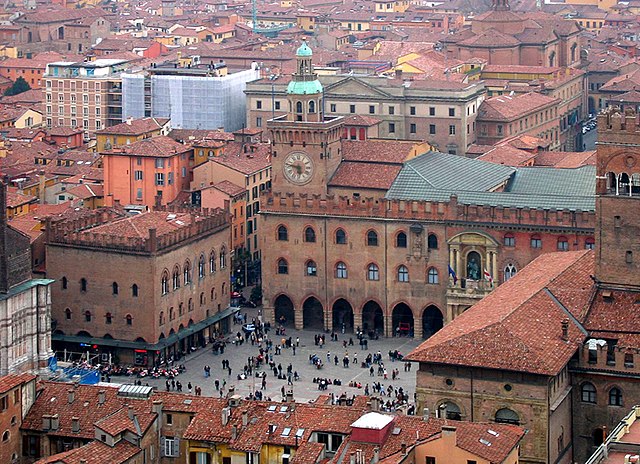University
academic institution for further education From Wikipedia, the free encyclopedia
Remove ads
A university is a higher learning institution. The word university comes from the Latin universitas magistrorum et scholarium, roughly meaning "community of teachers and scholars". [1] Students can go to university to get an academic degree. Unlike the schooling they have done before, the courses at university are specialised. A person studying biology at university has many courses about biology and fewer courses in other fields such as languages or history. To get a higher degree, people must do some research.
Not all subjects are offered at universities. Mainly, universities offer courses which are about knowledge. They usually do not offer courses in practical trades. In some cases such as law, where there are both knowledge and practical issues, the university does mainly the theoretical side of the subject. Practical qualifications are done elsewhere.
Remove ads
History

The universities were born in Europe during the Middle Ages. The first institution of this type was the University of Bologna, which later became a model for other centres of education.[2][3][4]
At first, the universities had formed themselves according to the model of the professional groups and like almost everything in the Middle Ages, they remained tied to the Catholic Church. At the beginning, they had worked to teach the so-called "seven liberal arts" (the trivium and the quadrivium):
That earliest division caused the present divisions between literary and scientific fields. From one point of view, the world's oldest university is Qarawiyyin university. However, teaching religion is not the definition used by most people. A university should in theory teach every subject.
The university is generally regarded as a formal institution that has its origin in the Medieval Christian tradition.[5][6] European higher education took place for hundreds of years in cathedral schools or monastic schools (scholae monasticae). There, monks and nuns taught classes: evidence of these dates back to the 6th century.[7]
The Universities of Paris and Oxford were founded by members of the church.[8] Later universities were founded by kings.
In the early medieval period, most new universities were founded from pre-existing schools, usually when these schools became mainly sites of higher education.[9] Pope Gregory VII promoted the concept of modern university as his 1079 Papal Decree. He ordered the establishment of cathedral schools, which eventually turned into the first European universities.[10]
Remove ads
Organisation
A university can include several campuses or different places where classes are taught by professors. In each campus there are several faculties and university schools (mainly for teaching), and also laboratories, departments and institutes of research. Many campuses also have housing for students in buildings called dormitories and structures like libraries, study rooms and gymnasiums for students that live there. Each school offers many courses that students take to earn a degree. The person with the highest right to control and to command in a university is the rector, who governs the university with the help of the party of vice-rectors and of other organs such as the social council and the governing body.
Remove ads
Notable universities
Australia
- The Australian National University
- University of Melbourne
- Monash University
- University of Sydney
- University of Queensland
- Deakin University
- University of New South Wales
Canada
- University of Alberta.:.
- Carleton University.:.
- University of Calgary.:.
- McGill University.:.
Chile
- University of Chile (Universidad de Chile)
- Catholic University of Chile (Universidad Católica de Chile)
- Metropolitan Technologic University (Universidad Tecnológica Metropolitana)
China; People's Republic
- Fudan University.::.
- Nanjing University.::.
- Shandong University.::.
- Sun Yat-sen University.::.
- Sichuan University Ranking.::.
- Xi'an Jiaotong University.::
- Zhejiang University.::.
Finland
- Åbo Akademi University
- Aalto University
- University of Helsinki
France Republic
- Paris-Saclay University.:
- University of Montpellier.:
- Grenoble Alpes University.:
- University of Lyon.:
Germany
- Free University of Berlin.:.
- Humboldt University of Berlin.:.
- Goethe University Frankfurt.:.
- Monash University.:.
Italy
Japan
Japan
- Hokkaido University.:.
- Hiroshima University.:.
- Keio University.:.
- University of Kyushu.:.
- Nagoya University.:.
- University of Tsikuba.::.
- Waseda University.::.
Malaysia
- University of Malaya
- Universiti Tunku Abdul Rahman
Mexico
- UNAM, Universidad Nacional Autónoma de México. The biggest and most important university in Mexico and Latin America
- UdG, University of Guadalajara.It is the second oldest university in Mexico, regarded as one of the most significant universities in Mexico.
- IPN, Instituto Politécnico Nacional
- ITESM, Instituto Tecnológico y de Estudios Superiores de Monterrey
- ITAM, Instituto Tecnoloógico Autónomo de México
Netherlands
- Delft University of Technology
- Eindhoven University of Technology
- Erasmus University Rotterdam
- Free University Amsterdam
Poland
- University of Warsaw
- Jagiellonian University
Romania
- Naval Academy "Mircea cel Batran" (ANMB)
South Korea
- Seoul National University
- Yonsei University
- Korea University
- Sungkyunkwan University
- Yonsei University
Sweden
- Chalmers University
- Karolinska Institute
- Lund University
- Royal Institute of Technology
- Stockholm School of Economics
- Uppsala University
- Umeå University
Turkey
- Bilkent University
- Boğaziçi University
- Çukurova University
- Ege University
- Gazi University
- Hacettepe University
- Marmara University
- Middle East Technical University
- Galatasaray University (İstanbul)
United Kingdom
- Aston University
- University of Birmingham
- University of Bristol
- University of Cambridge
- Coventry University
- University of Dundee
- Durham University
- University of Edinburgh
United States
There is a group of notable universities called the Ivy League. They are:
- Harvard University
- Princeton University
- Yale University
- Brown University
- Cornell University
- Dartmouth College
- Columbia University
- University of Pennsylvania
Some other universities are:
- George to Illinois State University
- University of California, Berkeley
- Ohio State University
- Yeshiva University
There are also institutions of technology who provide course offerings primarily in scientific and technological studies. Some examples are:
Remove ads
Related pages
References
Other websites
Wikiwand - on
Seamless Wikipedia browsing. On steroids.
Remove ads